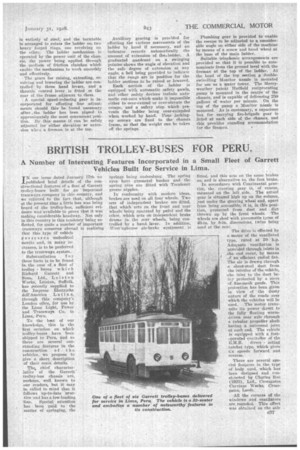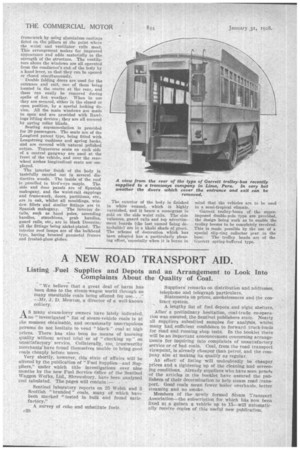BRITISH TROLLEY-BUSES FOR PERU.
Page 59

Page 60

If you've noticed an error in this article please click here to report it so we can fix it.
A Number of Interesting Features Incorporated in a Small Fleet of Garrett Vehicles Built for Service in Lima.
TN our issue dated January 17th we 'published brief details of the constructional features of a fleet of Garrett trolley-buses built for an important tramways company in this country, and we referred to the fact that although at the present time a little less was being heard of the trolley-bus, sufficient evidence was•available to prove that it wasmaking considerable headway. Not only in this country is this tendency being reflected, fer quite a number of important tramways concerns abroad is realising that this type Of vehicle possesses undoubted merits and,' in many flames, is to be preferred to the tramways system.
Substantiation f o r these facts is to be found in, the ease of a fleet of trolley busee which Richard Garrett and Sons, Ltd., L ei st on Works, Leiston, Suffolk, has recently supplied to the Imprese Elettriehe dell'Ami!rica Latin a, through this company's London office, for use by the Lima Light, Power and Tramways Co. ie Lima. Peru.
To the best of our knowledge, this is the first occasion on which trolley-buses have been shipped to Peru, and as there are several outstanding features in the construction of the vehicles, we propose to give a short description of their main details.
The. chief characteristics of the Garrett' trolley-bus chassis are, perhaps, well known to our readers, but it may be called to mind that it follows up-to-date practice and has a low-loading line.. Special attention has been paid to the matter of springing, the sPriuses being undersliteg. The spring eyes have gunmetal bushes and the spring pins are fitted with Tecalemit grease nipples..
In conformity with modern ideas, brakes, are used On all four wheels. Two sets of independent brakes are fitted, that which acts on the front and rear wheels being operated by pedal and the other, which acts on independent brake drums in the rear wheels, being controlled by a hand lever. In addition, West'ughouse• air-brake equipment is fitted, and this acts on the same brakes as, and is alternative to, the foot brake. In accordance with Continental prac tice, the steering gear is, of course, Mounted on the left side. The actual gear is situated high up on the column, just under the eteering wheel and, apart from being accessible, it is, in this position, protected from dust end dirt thrown up by the front wheels, The wheels are shod with pneumatic tyres of 40-in. by 8-in, dimensions, twins being used at the rear.
The drive is effected by a motor of the ventilated type, rated at 50 hip. Adequate ventilation is -provided through inlets in the end cover, by means ' of an efficient radial fan. The air is drawn through a sheet-steel duct from the interior of the vehiele, the inlet to the duct beire protected by a sieve of fine-mesh gau2e. This protection has been given in view of the dusty eaten of the roads over which the vehicles will be used. The motor trimsmits its power direct to the fully floating wormdriven rear axle through a tubular propeller shaft having a universal joint at each end. The vehicle is equipped with a footoperated controller of the
E.M.B. direct acting ratchet type, which gives six speeds forward and reverse.
There are several special features in the type of body used, which has been designed and constructed by Charles Roe 1,1923), Ltd., Crosseates Carriage Works, drossgates, Leeds..
All the cornera of the windows and ventilators etre. rounded. This effect was obtained on the side c37 framework by using aluminium castings fitted on the pillars at the point where the waist and ventilator rails meet. This arrangement makes for improved appearance and adds .materially to the strength of the structure. The ventilators above the windows are all operated from the conductor's end:of the bey by a hand lever, so that they can be opened or closed simultaneously.
Double folding doors are used for the entrance and exit, one of them being located in the centre at the rear, and these can easily be removed during spells of hot weather. When in use they are secured, either in the closed or open position, by a special locking device. All the main windows are made to open and are provided with Rawlings lifting devices; they are all covered 14 spring roller blinds.
Seating accommodation is provided for 30 passengers. The seats are of the Longford patent type, being fitted with Longstrong cushions and spring backs, and are covered with natural polished rattan. Transverse seats on each side of a central gangway are used at the front of the vehicle, and over the rearwheel arches longitudinal seats are employed.
The interior finish of the body is tastefully carried out in several distinctive woods. The inside of the roof is panelled in bird's-eye maple. The side and door panels are of Spanish mahogany, and the waist-rail cappings and framework, doors, partitions, etc., are in oak, whilst all mouldings, window fillets and similar fittings are in
Spanish mahogany. The interior details, such as hand poles, ascending handles, stanchions, grab handles, guard rails, etc., are in black Daverite, all the fittings being nickel-plated. The interior roof lamps are of the bulkhead type, having bronzed gunmetal frames and frosted-glass globes.
The exterior of the body is finished in white enamel, which is highly varnished, and it bears a monogram in gold on the side waist rails. The side valances, guard rails and top advertisement boards (the last. named being detachable) are in a khaki shade of green. The scheme of decoration which has been adopted has a particularly pleasing effect, especially when it is borne in mind that the vehicles are to be used in a semi-tropical climate.
Garrett trolley-bases of the superimposed double-pole type are provided, the design being such as to enable the trolley booms to be completely revolved. This is made possible by the use of a special slip-ring collector gear in the
base. The trolley heads are of the Garrett spring-buffered type.












































































































